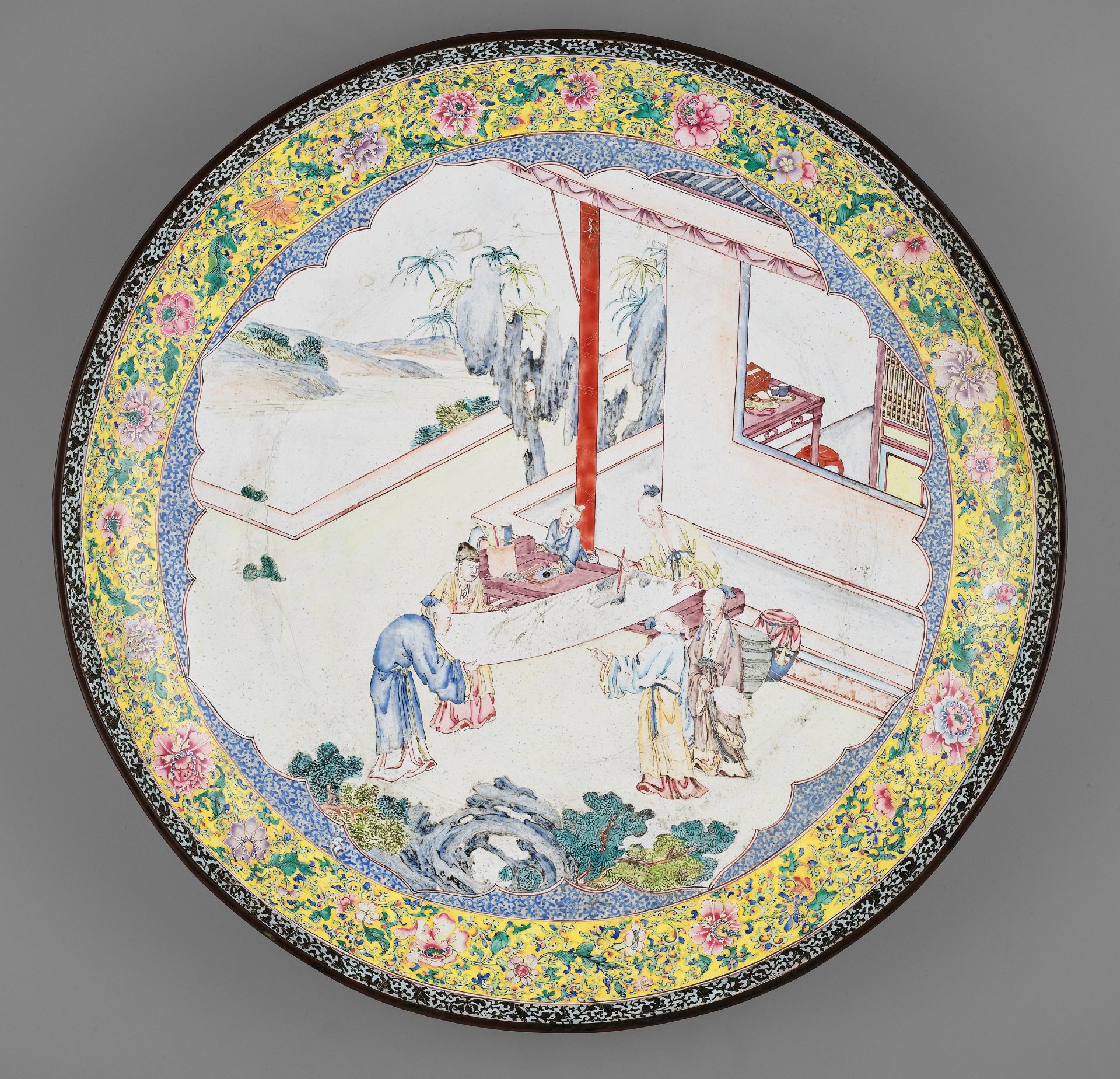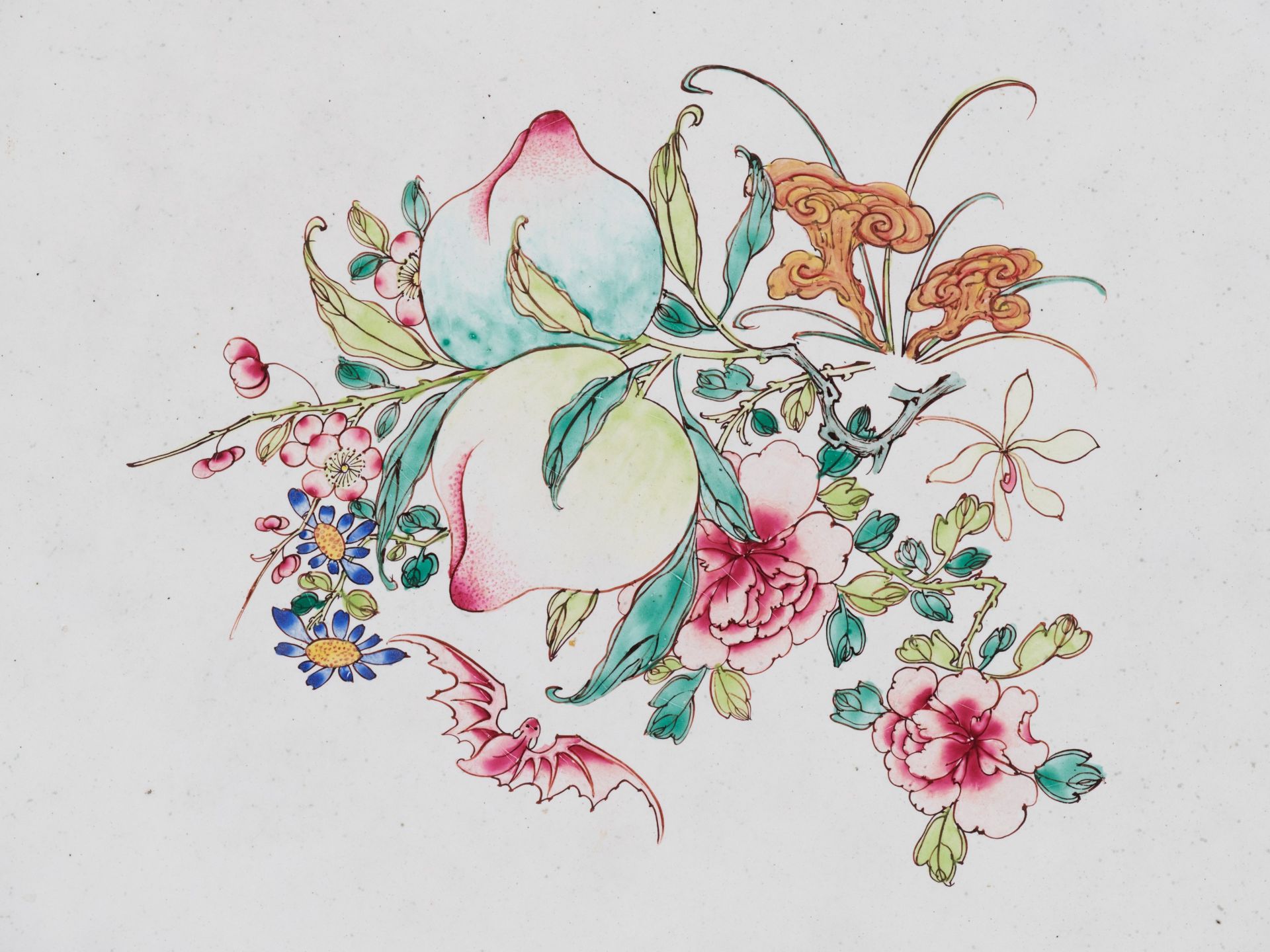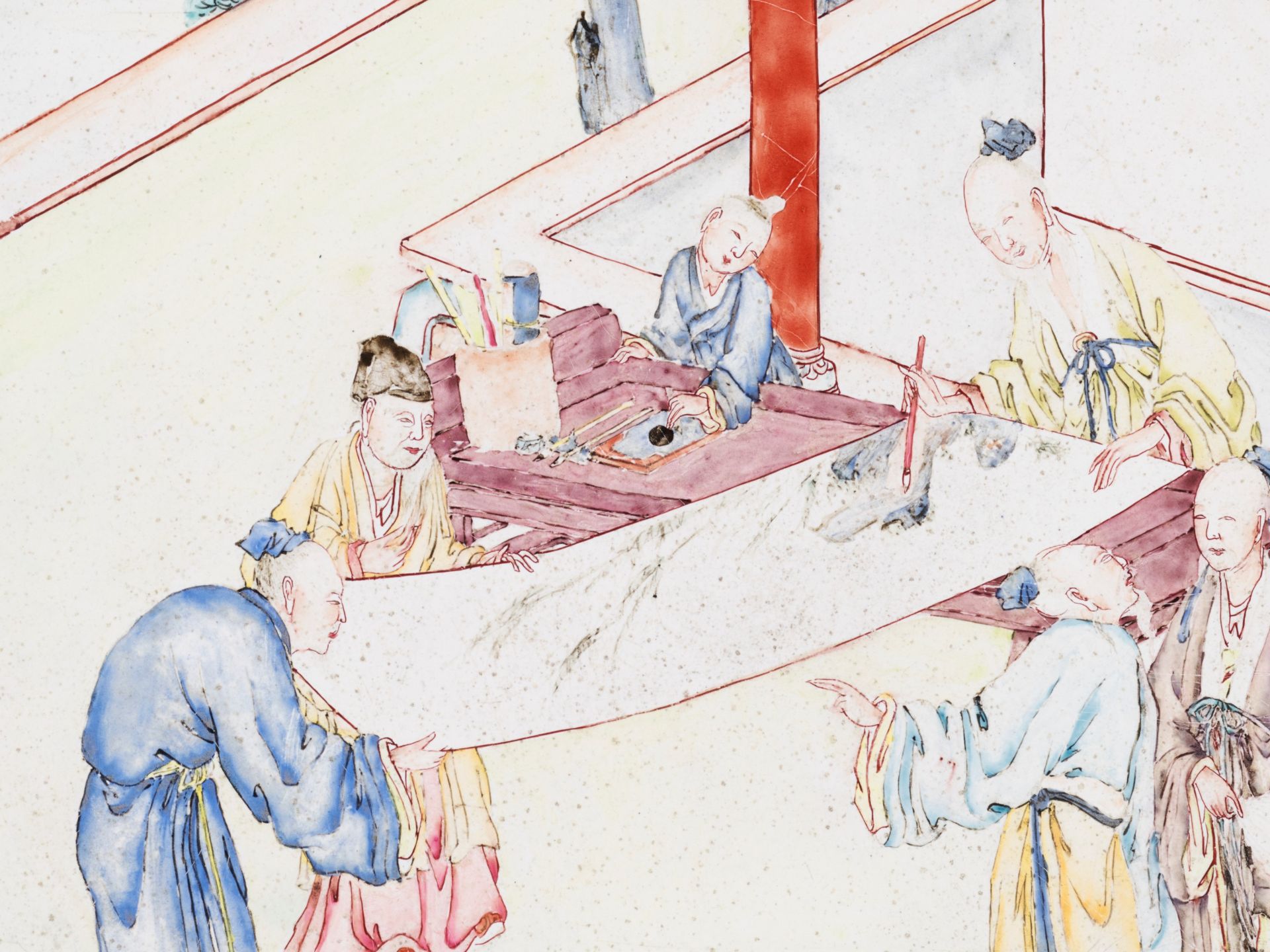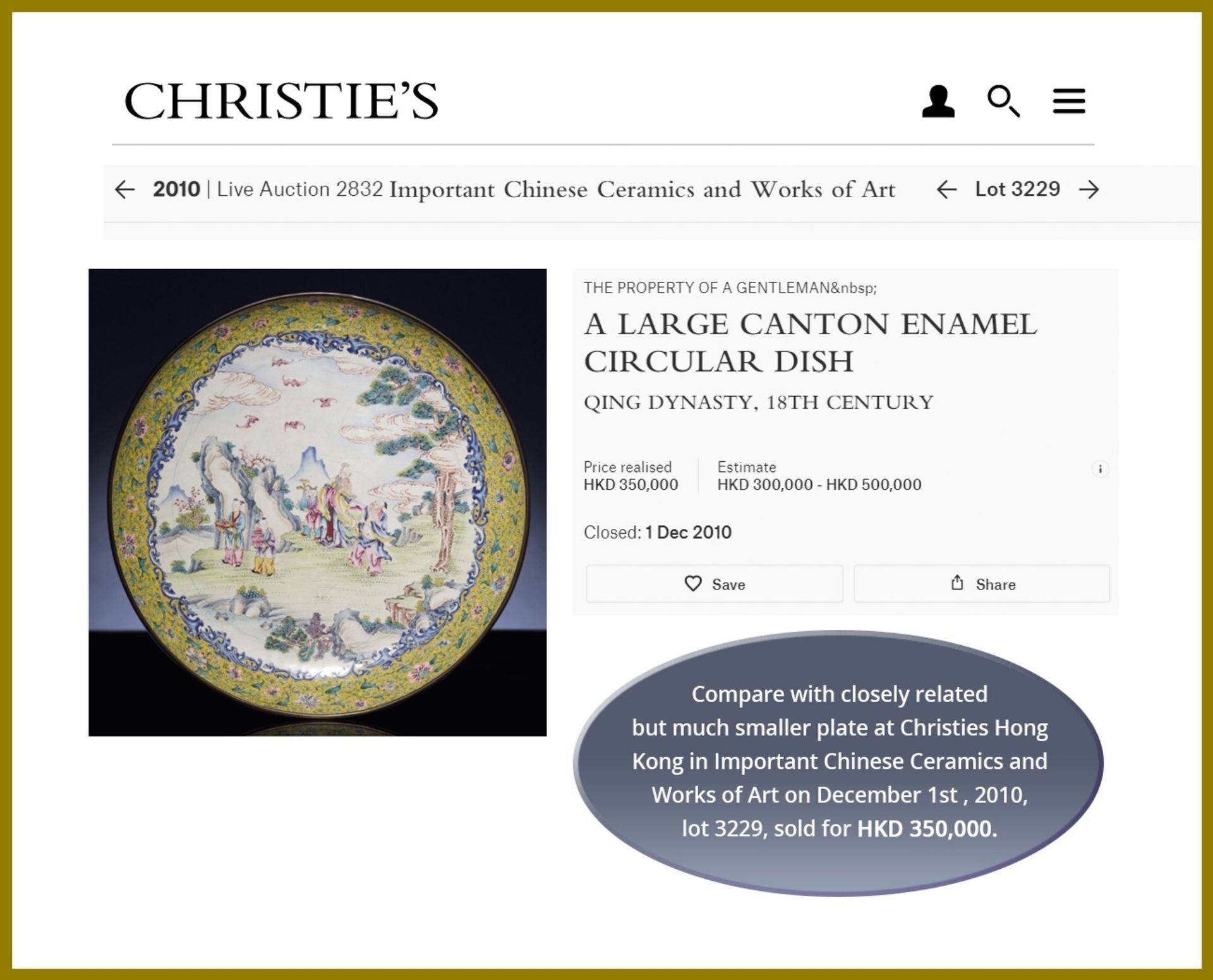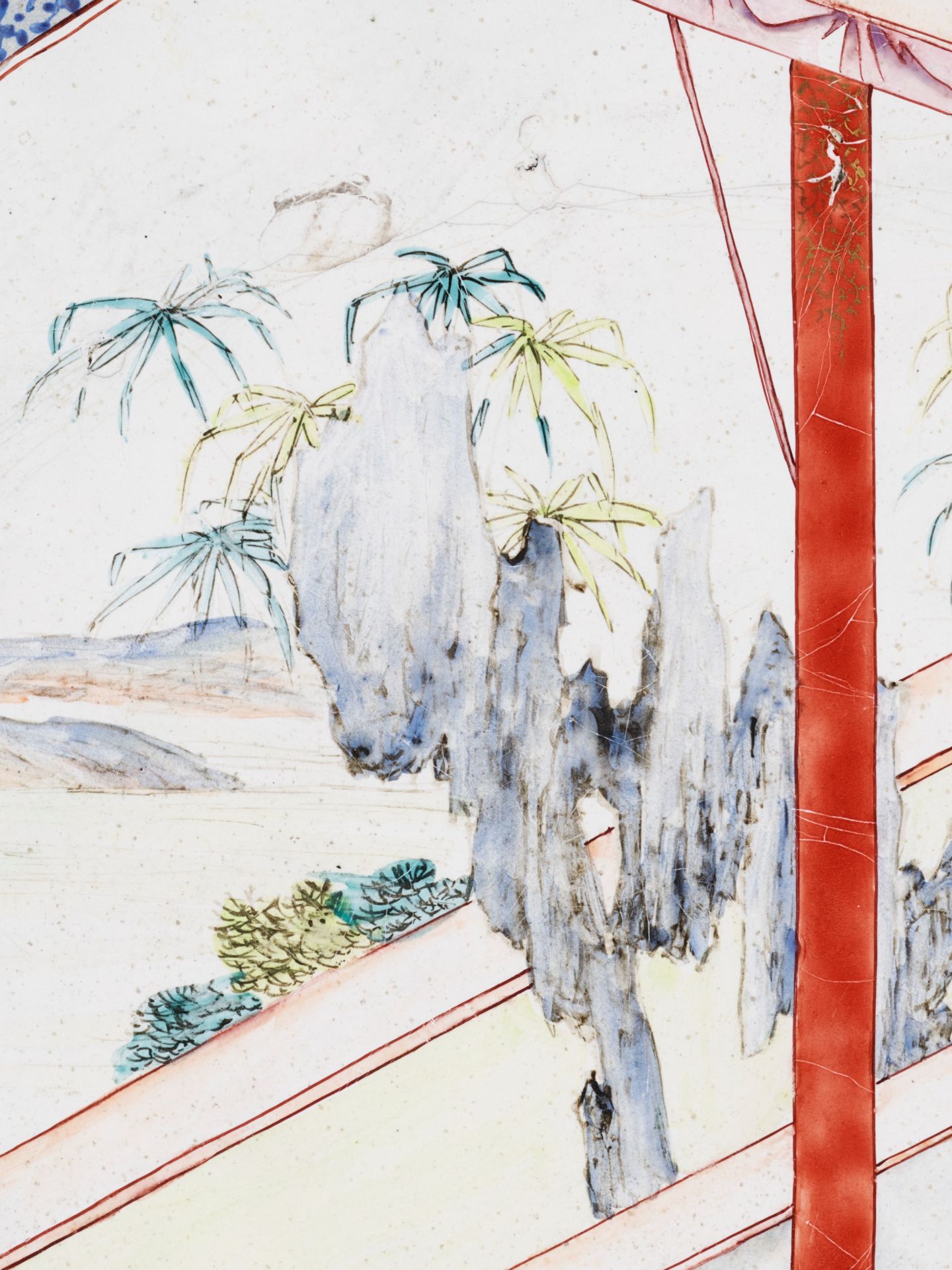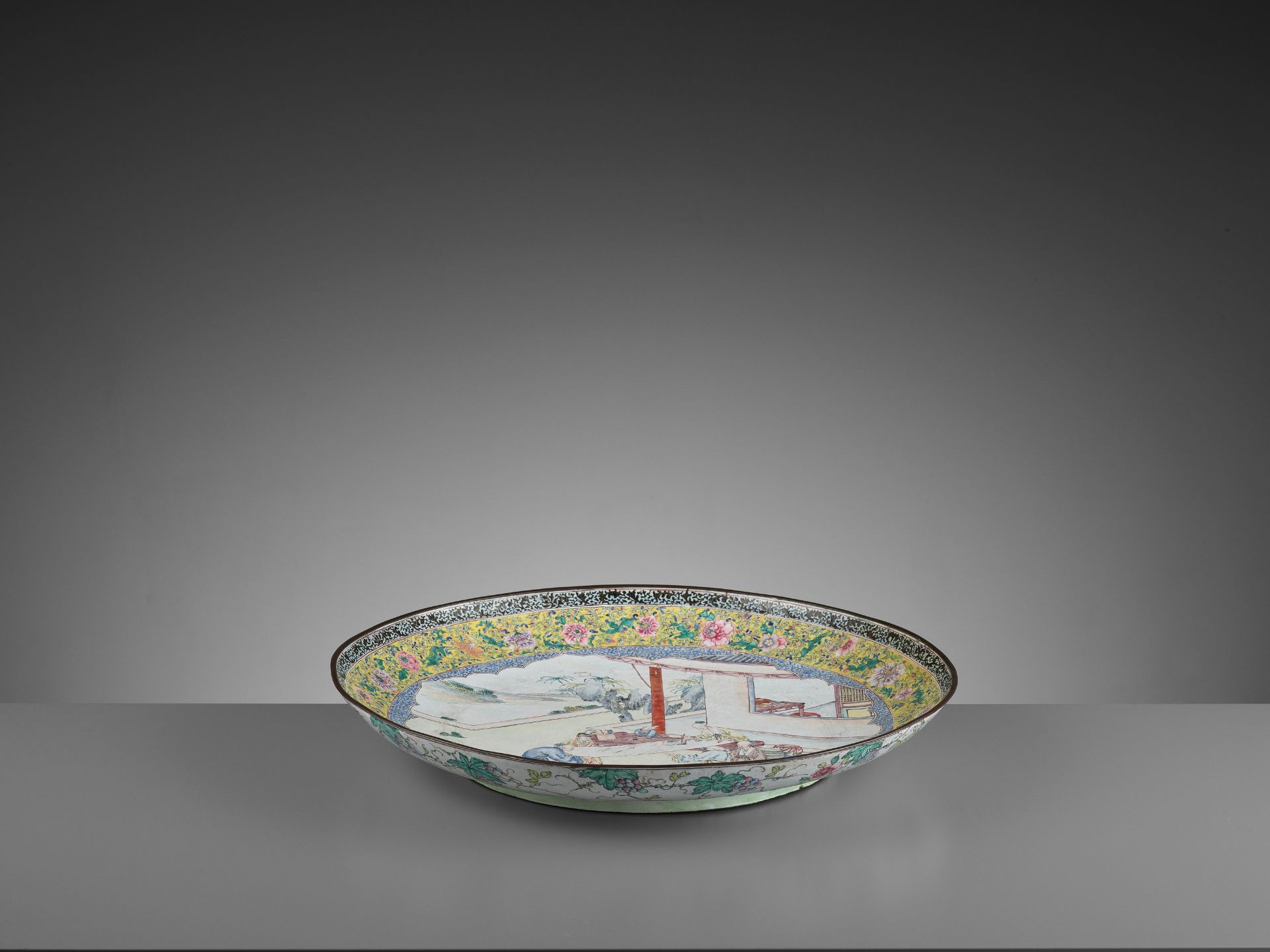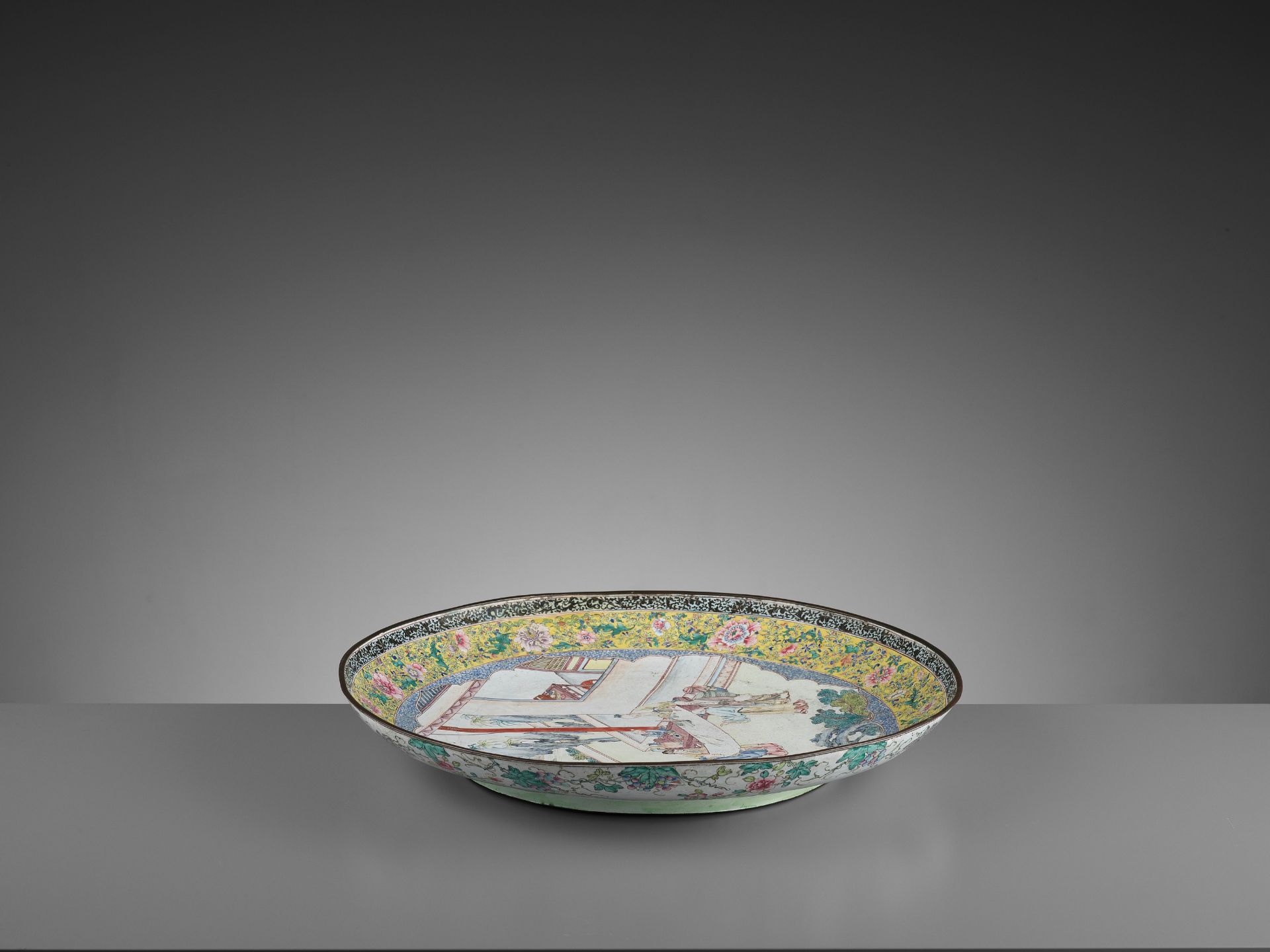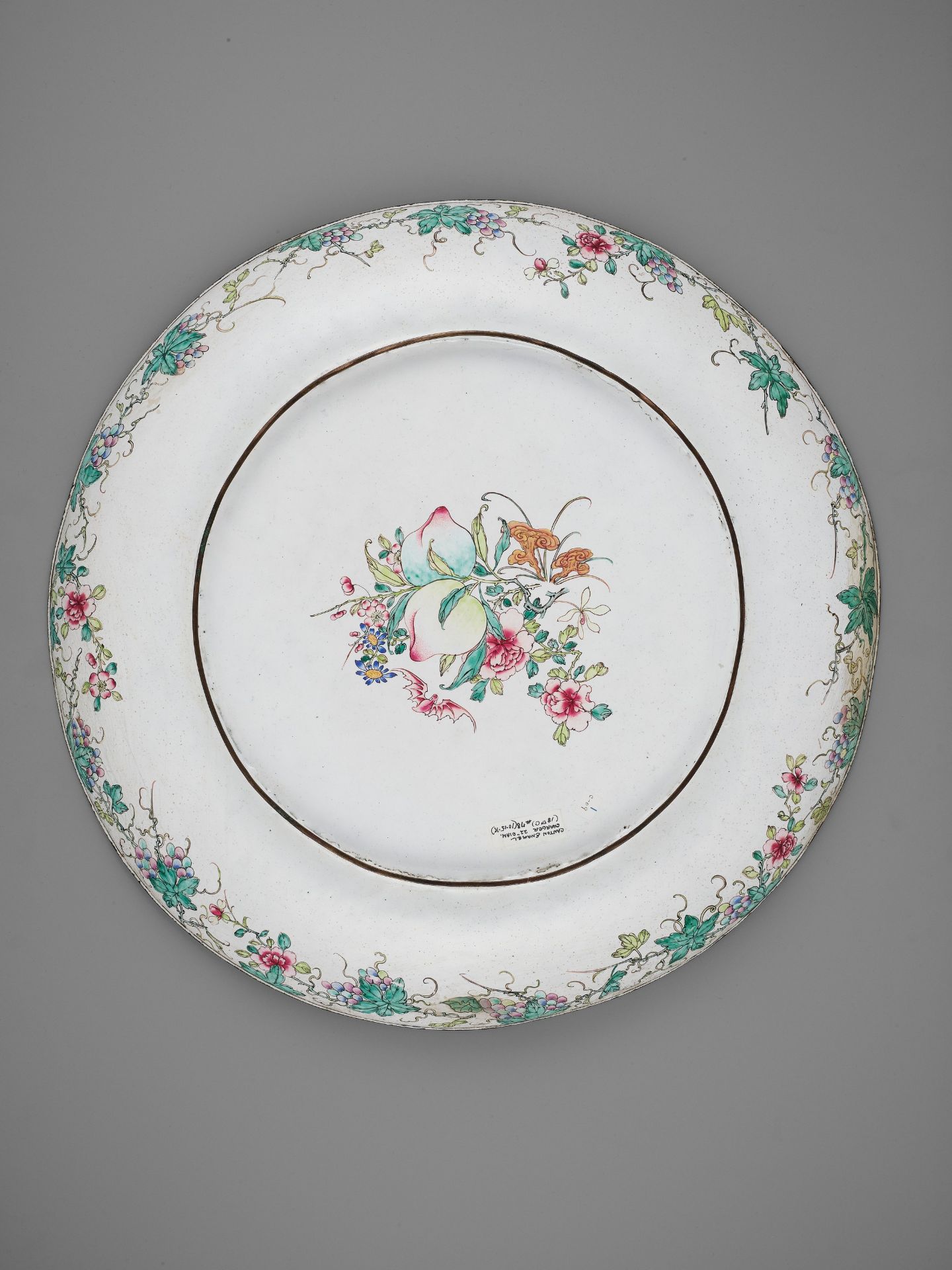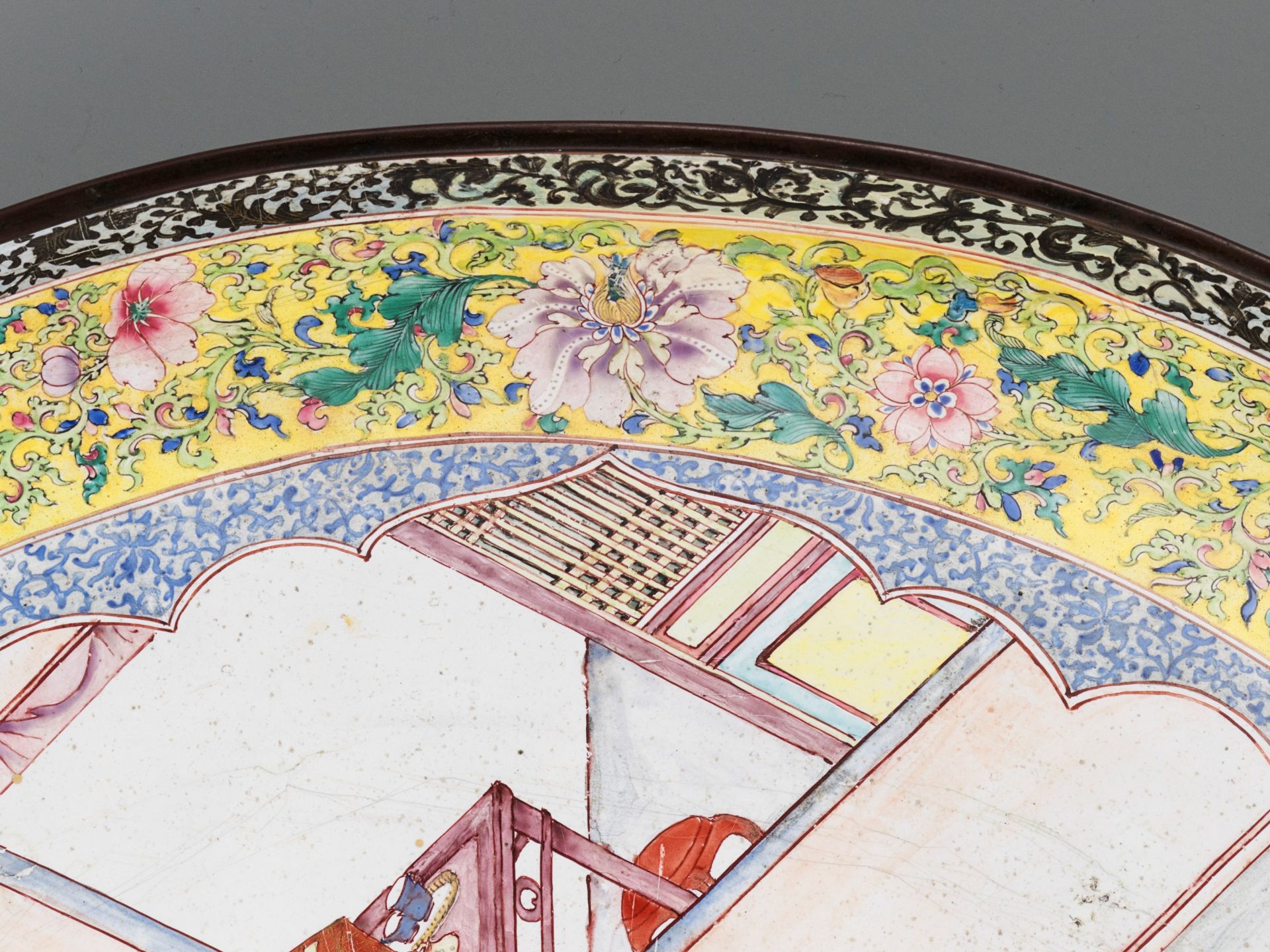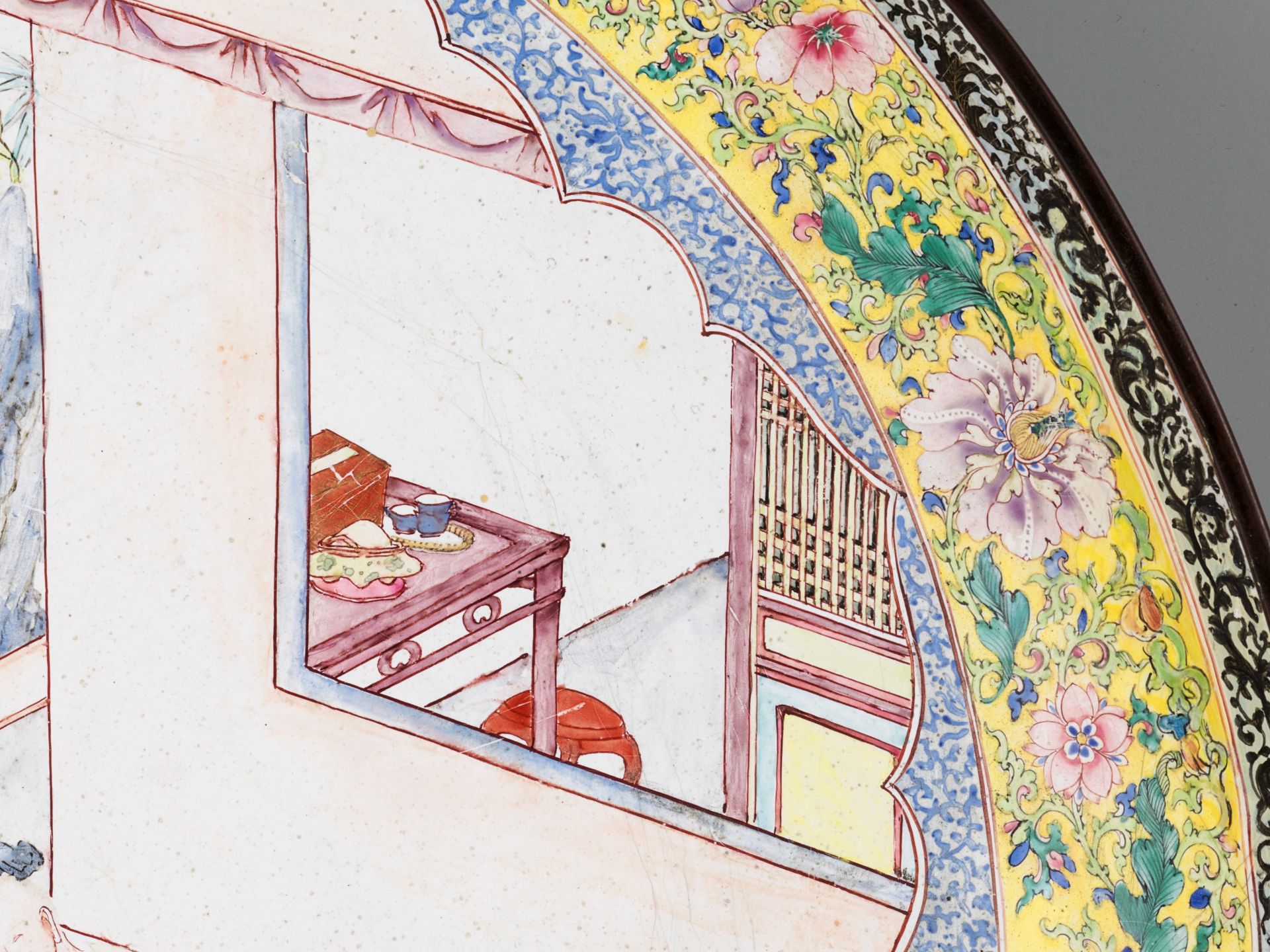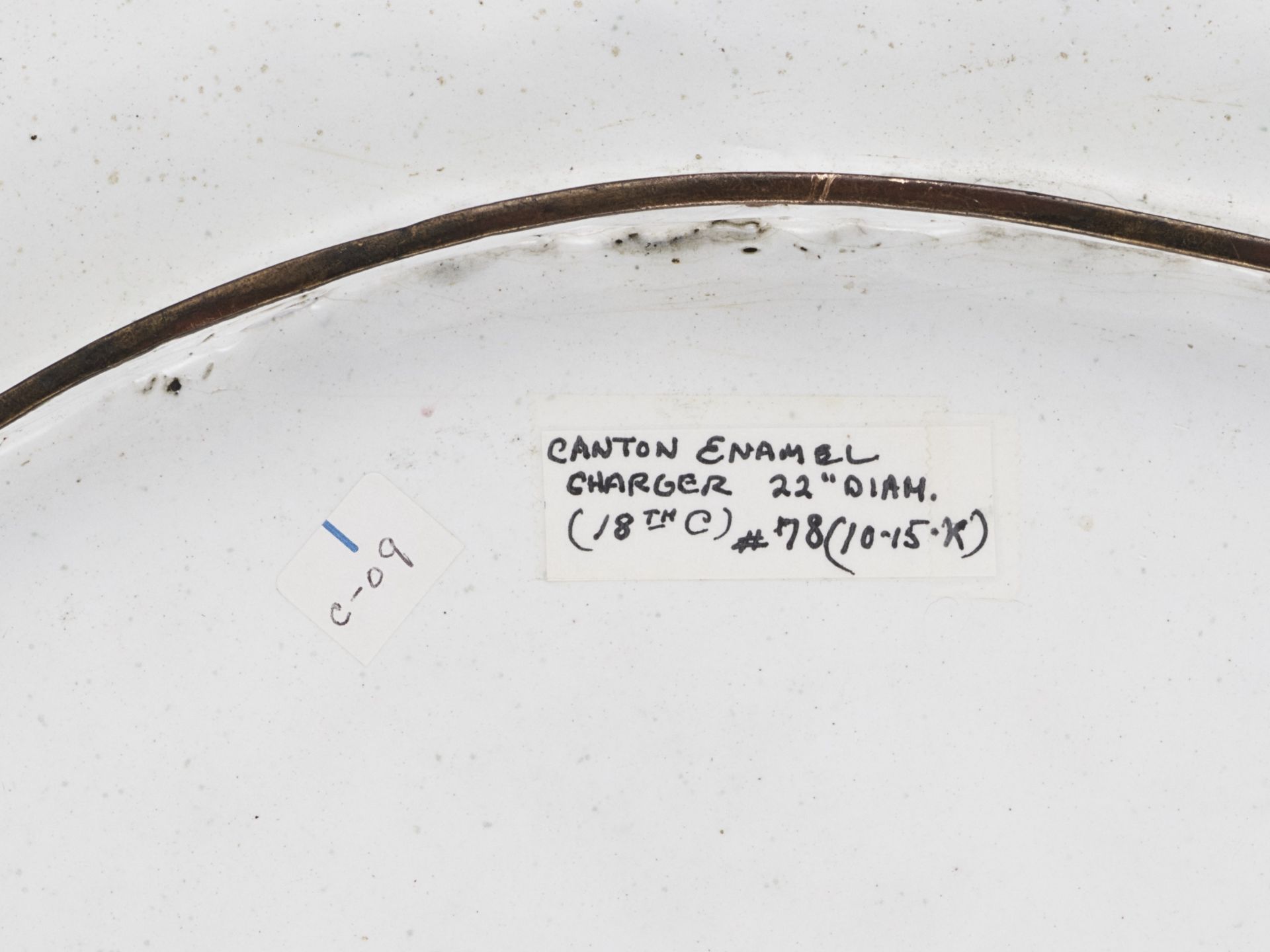9
AN EXCEPTIONAL AND VERY LARGE CANTON ENAMEL ‘SCHOLARS’ DISH, EARLY 18TH CENTURY
AN EXCEPTIONAL AND VERY LARGE CANTON ENAMEL ‘SCHOLARS’ DISH, EARLY 18TH CENTURY
China. This piece is notable for its imposing size, the broad surface of which has been delicately rendered with a rich scene of scholars, literati and pupils observing an artist working on a scroll, painted with bamboo springing from craggy rockwork, the yet unfinished oeuvre being the talk of the gathering.
Provenance: From a private estate in Pennsylvania, USA. The backside with an old collector’s label inscribed “C-09” and a second label with the inscription “Canton Enamel Charger 22” Diam. (18TH C) #78 (10.15.K)”.
Condition: The foot rim with a hole drilled for suspension. The center with circular hairlines along the foot and two old fillings, each the size of a coin. The outer border with an old, restored section of ca. 10-15 cm, barely extending into the yellow border, mirrored at the back. Minuscule firing flaws, pitting, hairlines, dents, losses and fills. The metal mounts with a fine, naturally grown patina. Old wear and traces of use. Overall, in good condition, especially considering the magnificent size of 2.365 cm², with less than 60 cm² of restored area, equivalent to only 2.5% (!) of the total surface.
Weight: 3.7 kg
Dimensions: 55 cm
Furthermore, we find a building with a terrace, a garden with scholar’s rocks, an imposing Ming dynasty altar table with a bitong and various brushes, an inkstone and several garden stools, as well as a peaceful lake and mountains in the far distance completing the inspiring scene.
The cavetto with a dense scroll of pink peonies and lavender-colored lotus against an Imperial yellow ground, all within two circumferential bands of leaves and vines. The reverse shows a neatly painted still life of two peaches, lingzhi, flowers and a single bat against a white ground. The border with a band of grapes.
The present dish is among the earliest examples of the successful combination of Western imaging techniques with traditional Chinese motifs during the first half of the 18th century. The subtle gradations of tone and the rendering of light and shade are particularly successful in the central panel, where cautious shading is introduced along the walls and canopy of the building. Even these few shades already give the composition a certain three-dimensional depth, heretofore unknown in Chinese painting. Moreover, the similarly rendered pink flowers are depicted in full bloom and appear to loom out from the contrasting yellow background. The fusion of East and West is therefore not only found on a technical level, but also in the stylistic approach to this painting, where the Chinese tradition of outlining has cleverly been combined with the European pursuit of naturalism through shading. Wares that combine a finely enameled scholarly motif on the interior with a vibrant yellow ground exterior were also produced in porcelain and celebrate the newly developed Famille Rose palette of the early eighteenth century. Tang Ying (1682–1756), as of 1728 the superintendent of the Imperial Kilns at Jingdezhen, notes in his work “A Brief Account of Ceramics”, that yangcai (Western color) enamel wares should be classified as combining falang glazes with Western painting styles (see the National Palace Museum exhibition catalog, Stunning Decorative Porcelains from the Qianlong Reign, Taipei, 2008, pp. 32-40).
Painting in enamels on copper is essentially a Western art that gained prominence in northern Europe during the Renaissance and flourished in China under the reign of the Qianlong emperor. Once the piece was shaped, the copper was prepared with a ground of plain enamel to receive the painting in glassy pigments which then bonded to it by firing. The resulting clear and brilliant contrast of colors, which allowed for ornate decoration, was particularly suited to the young Qianlong emperor's taste for the opulent and exotic. The technique was first introduced to Guangzhou by Jesuit missionaries who entered the port with samples of Limoges wares from Europe around 1700. It was then presented to the Palace Workshop between 1714 and 1716 by the enamel factories in Guangzhou, who supplied versatile artisans dedicated to developing and improving the standard of the imperial Enamel Workshop (see Yang Boda in the catalog to the exhibition Tributes from Guangzhou to the Qing Court, Art Gallery, The Chinese University of Hong Kong, Hong Kong, 1987, page 63).
Curator’s Summary: The frugal use of shading points to an early date during the first period of enamel production, which can possibly be even narrowed to 1710-1725. After this period, shading became more sophisticated and stippling was introduced. It is even possible that this monumental work, obviously conceived to impress, and difficult to make with the limited production capacities of the time, was among the few large template pieces presented to the Imperial Palace Workshop between 1714 and 1716 by the enamel factories in Guangzhou. This would explain the lasting albeit simplified reappearance of closely related scholarly motifs in later imperial works. Overall, the present dish must therefore not only be regarded as extremely rare, but also as an important contributor to what was later to become the most sophisticated producer of enamel wares in the history of mankind: The Imperial Palace Workshops in Beijing.
Literature comparison: A similar use of yellow ground with multi-colored floral scrolls along panels containing depictions of scholars in garden landscapes can be seen on a Qianlong hand-warmer – with a red enamel six-character Qianlong seal mark within a single square – in the collection of the National Palace Museum, Taipei (illustrated in Enamel Ware in the Ming and Qing Dynasties, p. 243, no. 134) although the frames of the panels on the hand-warmer are in red tones and created using more sophisticated abutted S- and C-shaped elements. The use of imperial yellow grounds ornamented with multi-colored floral scrolls was much admired by the court in the Qianlong reign and can be seen on a number of items in a range of forms preserved in the collections of the Palace Museum, Beijing, and the National Palace Museum, Taipei.
A scene of scholars in a garden setting, related to the one on the present plate, appears on a Qianlong enameled tea container in the collection of the State Museum of Oriental Art, Moscow (illustrated by Marina Neglinskaya in Kitayske raspisnie zmali, Moscow, 1995, cat. 38), although in the case of the Moscow piece, one scholar is playing the qin while another listens, and a servant approaches with refreshments. The enamels on the Moscow tea container are less rich than those on the present plate and the hand-warmer from the National Palace Museum Collection, and the dominant color in the background is blue rather than yellow, but it is interesting to note that the style was appreciated by the European elite as well as those in China.
Auction result comparison: Compare with a closely related but much smaller plate at Christie's Hong Kong in Important Chinese Ceramics and Works of Art on December 1st 2010, lot 3229, sold for HKD 350,000.
十八世紀初廣州銅胎畫琺琅開光文人賞畫圓盤
中國. 尺寸宏偉,盤内開光,繪畫精美,文人及其學生欣賞一位畫家在捲軸上作畫的場景,四周山水湖泊以及院内假山竹林。
來源: 美國賓夕法尼亞州私人遺產。盤底有老藏家的標簽 “C-09” 以及第二個標簽 “Canton Enamel Charger 22” Diam. (18TH C) #78 (10.15.K)”。
品相: 完整中文品相報告請至www.zacke.at查看。
其餘中文敘述請至www.zacke.at查看。
AN EXCEPTIONAL AND VERY LARGE CANTON ENAMEL ‘SCHOLARS’ DISH, EARLY 18TH CENTURY
China. This piece is notable for its imposing size, the broad surface of which has been delicately rendered with a rich scene of scholars, literati and pupils observing an artist working on a scroll, painted with bamboo springing from craggy rockwork, the yet unfinished oeuvre being the talk of the gathering.
Provenance: From a private estate in Pennsylvania, USA. The backside with an old collector’s label inscribed “C-09” and a second label with the inscription “Canton Enamel Charger 22” Diam. (18TH C) #78 (10.15.K)”.
Condition: The foot rim with a hole drilled for suspension. The center with circular hairlines along the foot and two old fillings, each the size of a coin. The outer border with an old, restored section of ca. 10-15 cm, barely extending into the yellow border, mirrored at the back. Minuscule firing flaws, pitting, hairlines, dents, losses and fills. The metal mounts with a fine, naturally grown patina. Old wear and traces of use. Overall, in good condition, especially considering the magnificent size of 2.365 cm², with less than 60 cm² of restored area, equivalent to only 2.5% (!) of the total surface.
Weight: 3.7 kg
Dimensions: 55 cm
Furthermore, we find a building with a terrace, a garden with scholar’s rocks, an imposing Ming dynasty altar table with a bitong and various brushes, an inkstone and several garden stools, as well as a peaceful lake and mountains in the far distance completing the inspiring scene.
The cavetto with a dense scroll of pink peonies and lavender-colored lotus against an Imperial yellow ground, all within two circumferential bands of leaves and vines. The reverse shows a neatly painted still life of two peaches, lingzhi, flowers and a single bat against a white ground. The border with a band of grapes.
The present dish is among the earliest examples of the successful combination of Western imaging techniques with traditional Chinese motifs during the first half of the 18th century. The subtle gradations of tone and the rendering of light and shade are particularly successful in the central panel, where cautious shading is introduced along the walls and canopy of the building. Even these few shades already give the composition a certain three-dimensional depth, heretofore unknown in Chinese painting. Moreover, the similarly rendered pink flowers are depicted in full bloom and appear to loom out from the contrasting yellow background. The fusion of East and West is therefore not only found on a technical level, but also in the stylistic approach to this painting, where the Chinese tradition of outlining has cleverly been combined with the European pursuit of naturalism through shading. Wares that combine a finely enameled scholarly motif on the interior with a vibrant yellow ground exterior were also produced in porcelain and celebrate the newly developed Famille Rose palette of the early eighteenth century. Tang Ying (1682–1756), as of 1728 the superintendent of the Imperial Kilns at Jingdezhen, notes in his work “A Brief Account of Ceramics”, that yangcai (Western color) enamel wares should be classified as combining falang glazes with Western painting styles (see the National Palace Museum exhibition catalog, Stunning Decorative Porcelains from the Qianlong Reign, Taipei, 2008, pp. 32-40).
Painting in enamels on copper is essentially a Western art that gained prominence in northern Europe during the Renaissance and flourished in China under the reign of the Qianlong emperor. Once the piece was shaped, the copper was prepared with a ground of plain enamel to receive the painting in glassy pigments which then bonded to it by firing. The resulting clear and brilliant contrast of colors, which allowed for ornate decoration, was particularly suited to the young Qianlong emperor's taste for the opulent and exotic. The technique was first introduced to Guangzhou by Jesuit missionaries who entered the port with samples of Limoges wares from Europe around 1700. It was then presented to the Palace Workshop between 1714 and 1716 by the enamel factories in Guangzhou, who supplied versatile artisans dedicated to developing and improving the standard of the imperial Enamel Workshop (see Yang Boda in the catalog to the exhibition Tributes from Guangzhou to the Qing Court, Art Gallery, The Chinese University of Hong Kong, Hong Kong, 1987, page 63).
Curator’s Summary: The frugal use of shading points to an early date during the first period of enamel production, which can possibly be even narrowed to 1710-1725. After this period, shading became more sophisticated and stippling was introduced. It is even possible that this monumental work, obviously conceived to impress, and difficult to make with the limited production capacities of the time, was among the few large template pieces presented to the Imperial Palace Workshop between 1714 and 1716 by the enamel factories in Guangzhou. This would explain the lasting albeit simplified reappearance of closely related scholarly motifs in later imperial works. Overall, the present dish must therefore not only be regarded as extremely rare, but also as an important contributor to what was later to become the most sophisticated producer of enamel wares in the history of mankind: The Imperial Palace Workshops in Beijing.
Literature comparison: A similar use of yellow ground with multi-colored floral scrolls along panels containing depictions of scholars in garden landscapes can be seen on a Qianlong hand-warmer – with a red enamel six-character Qianlong seal mark within a single square – in the collection of the National Palace Museum, Taipei (illustrated in Enamel Ware in the Ming and Qing Dynasties, p. 243, no. 134) although the frames of the panels on the hand-warmer are in red tones and created using more sophisticated abutted S- and C-shaped elements. The use of imperial yellow grounds ornamented with multi-colored floral scrolls was much admired by the court in the Qianlong reign and can be seen on a number of items in a range of forms preserved in the collections of the Palace Museum, Beijing, and the National Palace Museum, Taipei.
A scene of scholars in a garden setting, related to the one on the present plate, appears on a Qianlong enameled tea container in the collection of the State Museum of Oriental Art, Moscow (illustrated by Marina Neglinskaya in Kitayske raspisnie zmali, Moscow, 1995, cat. 38), although in the case of the Moscow piece, one scholar is playing the qin while another listens, and a servant approaches with refreshments. The enamels on the Moscow tea container are less rich than those on the present plate and the hand-warmer from the National Palace Museum Collection, and the dominant color in the background is blue rather than yellow, but it is interesting to note that the style was appreciated by the European elite as well as those in China.
Auction result comparison: Compare with a closely related but much smaller plate at Christie's Hong Kong in Important Chinese Ceramics and Works of Art on December 1st 2010, lot 3229, sold for HKD 350,000.
十八世紀初廣州銅胎畫琺琅開光文人賞畫圓盤
中國. 尺寸宏偉,盤内開光,繪畫精美,文人及其學生欣賞一位畫家在捲軸上作畫的場景,四周山水湖泊以及院内假山竹林。
來源: 美國賓夕法尼亞州私人遺產。盤底有老藏家的標簽 “C-09” 以及第二個標簽 “Canton Enamel Charger 22” Diam. (18TH C) #78 (10.15.K)”。
品相: 完整中文品相報告請至www.zacke.at查看。
其餘中文敘述請至www.zacke.at查看。
TWO-DAY AUCTION - Fine Chinese Art / 中國藝術集珍 / Buddhism & Hinduism
Sale Date(s)
Venue Address
For Galerie Zacke delivery information please telephone +43 1 5320452.
Important Information
We’ve updated our terms and conditions to better protect all serious and committed buyers from bidding against non-payers. Bidders must clarify all questions specifically about the objects before the auction. A sale cancellation of any kind after the fall of the hammer is not possible. The only exception to this fundamental rule is our guarantee of authenticity. We encourage you to read through these updates carefully (§34-50). For further reading about non-payers at auction, click here.
According to the general terms and conditions of business of Galerie Zacke Vienna, Founded 1968, SZA Versteigerungen & Vertriebs GmbH, 1070 Wien, online at www.zacke.at.
ABSENTEE BIDDING
Absentee bids are carried out under the regulations of the terms of business of Galerie Zacke, SZA Versteigerungen & Vertriebs GmbH, which requires written submission of your purchase limit. Orders without purchase limits cannot be processed.
Only the submitted lot number of the auction lot is binding for the processing of the absentee bid. The place of jurisdiction is Vienna, Austrian Law and Austrian jurisdiction are exclusively applicable for all legal questions arising from the business relationship. Absentee bids for this auction will be accepted until the day of auction by 10:00 a.m. We regret that absentee bids received after the time stated above will not be processed until after the auction.
PLEASE SEND ABSENTEE BIDS FOR THIS AUCTION TO:
Fax: +43 1 532 04 52 20 or
Email: office@zacke.at or
Mail: Galerie Zacke, Mariahilferstrasse 112, Stiege 1, 2. Stock, 1070
Wien, Austria, Europe
WE ACCEPT THE FOLLOWING METHODS OF PAYMENTS:
• Cash
• Certified or personal check
• Bank transfer (please inquire to receive our bank account information)
• Credit card (Visa, MasterCard, Amex, Diners Club)
TELEPHONE BIDDING
It is generally possible to bid by telephone during the auction. Please fill out the absentee bidding form enclosed in this catalog and include your telephone number at which you can be reached during the auction. In the “bid in euro” column please write “TEL” and then send us the completed absentee bidding form. Galerie Zacke will call you on the day of the auction, on the telephone number provided, 5 lots before the lot you are bidding on and the bidding will commence at the starting price, as stated in the catalog. If Galerie Zacke cannot reach you during the auction, Galerie Zacke will bid up to the estimate on your behalf.
ESTIMATES AND STARTING PRICES
The auction will begin with the starting price and written bids will be accepted only with a minimum amount equivalent to the starting price.
SHIPPING AND TRANSPORT INSURANCE
For domestic shipping Galerie Zacke (hereinafter called “the company”) charges in average Eur 15,- to Eur 50,- per item, depending on size and weight. These fees cover the costs of packing and shipping. Fees for bulky or fragile items, or international shipping will be quoted upon request.
The purchased goods are transported at the risk of the customer following handover of the packaged item to the post office or another carrier which the customer agrees to through his/her submission of the purchase order. According to the specific wish of the customer, the auctioned goods may be insured for the value of the purchase price (highest bid and all surcharges). This insurance fee is 3% of the purchase price. For any lots with a purchase prices exceeding EUR 350,- the transport insurance will be automatically arranged by the company if it does not expressively receive the purchaser’s written denial of this service and signed waiver of claims. Payments due to the company under the insurance contract will be charged to the customer. The company is also entitled to assign claims under the insurance contract to the customer providing the terms of the insurance contract do not prevent this. In any case, the company is only required to make payment to the customer specifically if payment has effectively been received from the insurance company.
COLOR AND CONDITION
Auction lots will be exhibited for viewing prior to the auction, thus offering all interested customers the opportunity to examine the quality and condition of the works exhibited. The catalog illustrations are intended to assist customers during such preview. In illustrations, printed colors do not correspond exactly to the originals. The printed catalog images are not representative for the condition of the illustrated pieces. Hidden flaws and damages are indicated in the condition report. The illustrations in our online catalogs can be strongly magnified, so that most damages and restorations are well recognizable.
ENDANGERED SPECIES / CITES INFORMATION
Some items in this catalog may for example consist of ivory, rhinoceroshorn, tortoise shell, or some types of tropical wood, and are subject to the Convention on International Trade in Endangered Species of Wild Fauna and Flora [CITES]. Such items are marked with the symbol Ɏ on www.zacke.at and may only be exported outside the European Union after an export permit in accordance with CITES has been granted by the Austrian authorities. We would like to inform you that such licenses are typically not granted. For objects which have a low ivory content or have been proven beyond doubt to be in the EU before 1982, please contact our office for more information on how to obtain a CITES license.
COMPLAINTS
At its auctions, Galerie Zacke sells consigned lots on behalf of third-party consignors. For this reason, any complaints related to purchased lots must be in accordance with §32-48 of the general terms and conditions of business of Galerie Zacke, which can be found on www.zacke.at
IMPORTANT INFORMATION
Whenever making a bid, whether personally or via an agent, in writing, online, telephone, or in any other way, the bidder fully and unconditionally accepts the Terms of Auction, the ‘Important Information’ section in the auction catalog, the Terms and Conditions (AGB) of Galerie Zacke, §1-48, the Fee Tariff, and the Bidding Increments table, all as published on www.zacke.at on the day of the auction
THE ART LOSS REGISTER
All items starting above 2.000,- EUR have been checked by the Art Loss register
Terms & Conditions
TERMS OF AUCTION
Buyer’s Premium 26.4% including VAT
Online Bidding Fee 3% including VAT
Further information please read § 3
§ 1) The auction shall be carried out in accordance with the provisions of the rules of procedure of GALERIE ZACKE©, SZA VERSTEIGERUNGEN UND VERTRIEBS GMBH, MARIAHILFERSTRASSE 112, 1070 WIEN (hereinafter referred to as the company) as well as in accordance with sections 244-246 of the GEWERBEORDNUNG [Industrial Code] of 1994. The auction shall be carried out on commission. The auctioneer shall be entitled to withdraw lots exceptionally, to conduct the auction deviating from the order of the catalog numbers and to offer lots jointly. In the event of any dispute concerning a double bid or if the auctioneer has missed a bid, the auctioneer shall be entitled to revoke acceptance of a bid and to continue auctioning the item. The figures stated in the catalog shall be the highest bid in Euro (€) expected by the respective expert. As a rule, the bid shall be increased by 10% of the last bid. (See table of the bidding increments).
§ 2) The acceptance of a bid shall be granted to the highest bidder unless a hidden reserve has been agreed upon with the consignor of the item in question. Such a hidden reserve (also called limit or just reserve) shall be the minimum price under which the item will not be sold during the auction. This reserve will be disclosed upon request and after the auction only and may exceed the estimate. The auctioneer will in this case bid on behalf of the seller against all other bidders until the reserve has been reached. If a reserve is not reached during the auction, the auctioneer will knock down the item to the highest bidder at the final bid, but the sale will be conditional of the acceptance of this final bid by the seller. In this case the highest bidder shall be bound to his/her last bid for a term of 8 days starting with the day of the knockdown. If the winning bidder does not receive a written cancellation notice within this term of 8 days, the knockdown becomes unconditional and the sale is final. Typically, only a minority of all items in an auction have a hidden reserve.
§ 3) Most items shall be subject to differential taxation. A uniform surcharge of 22% plus the value added tax applicable to the surcharge to the amount of 20% shall be added to the achieved highest bid (final and highest bid). Thus, the surcharge shall be 26.4% of the final and highest bid in total. Items with added VAT are marked in the online catalog. For online bids an additional 3 % will be charged.
§ 4) In the event of sales abroad, the value added tax will be repaid if the item is sold to a country which is not a member country of the European Union (third country), the legal requirements are met, and the proof of exportation is provided. The value added tax shall not be shown separately on the invoice.
§ 5) The auction buyer must pay the purchase price immediately upon acceptance of the bid (final and highest bid plus 22% surcharge, plus the value added tax applicable to the surcharge to the amount of 20%, or the added VAT on top of the final price, when a lot is highlighted accordingly in the auction catalog). The company may grant an auction buyer a term of payment for the purchase price in whole or in part when this has been formally applied for in writing before the auction.
§ 6) In the event of a term of payment, or any payment delay, in whole or in part, the company shall be entitled to charge default interest (12% p.a.) as well as storage charges (2.4% pf the final and highest bid per month commenced) after 14 days upon acceptance of the bid. The item purchased at auction shall be handed over exclusively upon full payment of the purchase price including all costs and charges accrued since the acceptance of the bid.
§ 7) The buyer should take acquired items into possession, as far as possible, immediately or after the end of the auction. Items which have been fully paid for shall be handed over in our show rooms in GALERIE ZACKE, MARIAHILFERSTRASSE 112, 1070 VIENNA. If a deferred purchase price is not paid within the set period, the company shall be entitled to auction the item again in order to recoup its claim from the defaulting auction buyer. In this case, the defaulting auction buyer shall be liable to the company for the total loss of commission incurred by the company due to the re-auctioning as well as for any default interest and storage charges.
§ 8) The company shall be entitled to a lien on all items of the buyer irrespective of whether the buyer bought them within the scope of an auction or in free sale or the company secured ownership of these items otherwise. This lien shall serve to secure all current and future, qualified, limited and unmatured claims to which the company is entitled and which result from all legal transactions concluded with the buyer.
§ 9) The items received for auction will be exhibited and may be viewed prior to the auction. In doing so, the company shall give everyone the opportunity to check the nature and the condition of the exhibited items to the extent deemed possible within the scope of the exhibition. Every bidder shall be deemed to act on its own behalf unless it provides a written confirmation saying that it acts as a representative or agent of a well-known principal. The company may refuse bids; this shall particularly apply if a bidder who is unknown to the company or with whom the company has no business connections yet does not provide a security deposit before the auction. However, in principle there shall be no claim to accept a bid. If a bid has been refused, the previous bid shall remain effective.
§ 10) The company’s experts evaluate and describe the items received for auction and determine the starting prices unless otherwise stated in the catalog or expert opinion. The information concerning production technique or material, state of preservation, origin, design and age of an item is based on published or otherwise generally accessible (scientific) findings concluded by the company’s expert with the necessary care and accuracy. The company shall warrant to the buyer according to §34-38 of the AGB (Terms and Conditions) that properties are correct provided that any complaints referring to this are made within 45 days after the auction day. Subsequent complaints shall be excluded in principle. The company shall not be liable for any further information in the catalog and expert opinion as well. This shall also apply to illustrations in the catalog. The purpose of these illustrations is to guide the potential buyer during the preview. They shall not be authoritative for the condition or the characteristics of the pictured item. The published condition reports shall only mention defects and damage affecting the artistic or commercial value significantly. Complaints concerning the price shall be excluded upon acceptance of the bid. The company reserves the right to amend the catalog online prior to the auction. These amendments shall also be made public orally by the auctioneer during the auction. In this case, the company shall be liable for the amendment only. All items offered may be checked prior to the auction. These items are used. Any claims for damages exceeding the liability named above and resulting from other material defects or other defects of the item shall be excluded. When making the bid, the bidder confirms that he/she has inspected the item prior to the auction and has made sure that the item corresponds to the description.
§ 11) If a customer is not able to participate in an auction personally, the company shall accept purchase orders. These orders may be placed in writing via mail, e-mail, fax, www.zacke.at or a third party bidding platform. In the case of a purchase order placed by phone or orally, the company shall reserve the right to make the performance dependent on a confirmation from the principal communicated in writing. Furthermore, the company shall not be liable for the performance of purchase orders. Equal purchase orders or live bids will be considered in the order of their receipt. Bids which below the estimate shall be exhausted completely. Bids which do not correspond to the increments determined by the company (see bidding increment table) will be rounded up to the next higher increment. The table of these increments can be sent upon request. The written bid (purchase order) must include the item, the catalog number and the offered top bid limit which is quoted as the amount of the acceptance of the bid without buyer’s commission and without taxes. Ambiguities shall be carried by the bidder. A purchase order which has already been placed may only be cancelled if the written withdrawal is received by the company at least 72 hours prior to the beginning of the auction.
§ 12) The company may refuse a purchase order without explanation or make its execution dependent on payment of a security deposit. In the event of an unsuccessful order, such a deposit will be reimbursed by the company within 5 working days. Processing of purchase orders is free of charge.
§ 13) Every seller shall in principle be entitled to withdraw the items offered for auction until the start of the auction. Therefore, it is impossible to assume liability or to give warranty for the actual offering.
§ 14) Paid items must be collected within 30 days after payment. Items which have not been collected may be re-offered without further communication at the starting price from the recent auction reduced by 50%. Items which have not been collected within 30 days after the auction or for which the company does not receive any proper shipping instructions stating the type of shipping and the address of dispatch (independent of a possibly placed purchase order) shall be stored at the owner’s risk. Furthermore, the company shall be entitled to store items which have been purchased at auction and paid but not collected at the buyer ś risk and expense, including the costs for an insurance, with a forwarding agency. It shall be understood that the provision concerning the re-auctioning of unpaid and paid but not collected items must also apply to items not exhibited or stored on the premises of the company. The ownership shall be transferred to the buyer at the time of handing over the issuing note.
§ 15) In the case of mixed lots with a starting price of less than EUR 350.00, the company shall not warrant for the completeness or correctness of the individual items within a mixed lot.
§ 16) A registration for a bid by telephone for one or several items shall automatically represent a bid at the estimate price of these items. If the company cannot reach a bidder by telephone, it will bid on behalf of this bidder up to the estimate price when the respective lot is up for auction.
§ 17) Payments made to the company by mistake (through the payer ś fault) (e. g. due to miscalculation of the exchange rate by the payer) or payments made to the company for the same invoice several times shall be compensated in form of a credit note for goods for an indefinite period of time. The repayment of such payments in cash shall be excluded.
§ 18) Certain auction lots may exist several times (multiples). In such a case, the auctioneer may accept a second, third or even more bids from the underbidder(s). In this case, the text in the catalog and not the illustration shall be exclusively binding with regard to the warranty.
§ 19) The company reserves the right to assign to the buyer all rights and obligations resulting from the contractual relationship between the company and the seller by way of a respective declaration, as well as to assign to the seller all rights and obligations resulting from the contractual relationship between the company and the buyer by way of a respective declaration, in each case in terms of a complete assignment of contract with the result that the contractual relationship - following the submission of the aforementioned declarations by the company – shall exclusively be between the seller and the buyer, all of which is in accordance with the basic model of the commission agreement. Buyers and sellers shall already now give their explicit consent to this contract assignment.
§ 20) The place of performance of the contract brought about between the company on the one hand and the seller as well as the buyer on the other hand shall be the place of business of the company. The legal relationships and contracts existing between the company, the sellers and the buyers shall be subject to Austrian law. The company, the sellers and the buyers shall agree to settle all disputes resulting from, concerning and in connection with this contract before the territorially competent court of Vienna.
§ 21) The export of certain art objects from Austria shall require a permit from the Bundesdenkmalamt [Federal Monuments Office]. The company will orally provide information about art objects for which such export permit will probably not be granted at the beginning of the auction.
§ 22) Whenever making a bid, whether personally or via an agent, in writing, online, telephone, or in any other way, the bidder fully and unconditionally accepts the Terms of Auction, the ‘Important Information’ section in the auction catalog, the Terms and Conditions (AGB) of Galerie Zacke, §1-48, the Fee Tariff, and the Bidding Increments table, all as published on www.zacke.at on the day of the auction.


























